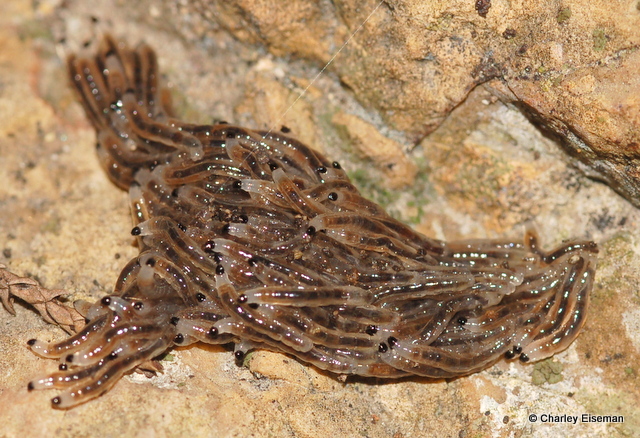It’s been two and a half months since my last post—not, of course, because I’ve run out of things to write about, but because there’s too much going on at this time of year for me to find the time to write anything. To compound this busy-ness, Julia and I took a nearly three-week road trip last month to look for leafminers in Colorado and the Midwest. Ever since we got back, emerging leafminers have taken up most of the waking hours that I haven’t been at work. But since this blog has just reached 500 subscribers, I thought I’d throw together a little something to mark the occasion.
On July 1, we met up with ant taxonomist and all-around great naturalist James C. Trager at Shaw Nature Reserve just west of St. Louis, Missouri. Toward the end of our walk, we happened on something I’ve been wanting to see for a long time: a wriggling mass of dark-winged fungus gnat (Sciaridae) larvae on the move.
A year ago, I asked Rob Deady (as far as I can tell, the only person in North America who studies dark-winged fungus gnats) about this phenomenon. He said that the behavior seems always to be triggered by water, and indeed it had just been raining a few hours before we encountered these larvae. In these masses, the larvae crawl across a film of mucus that they secrete, probably in search of a drier area to pupate rather than to continue feeding, but this apparently hasn’t been studied very thoroughly. The behavior is exhibited by many Sciara species, including S. militaris and S. thomae, as well as members of other genera such as Bradysia bicolor, Cratyna perplexa, and Ctenosciara hyalipennis.
My camera has no video feature, but after taking the above photos I borrowed Julia’s camera and made a couple of short, shaky videos with it. Below, you can watch the most in-focus parts, which Julia edited together with a much better clip that she made by resting the camera on the ground (that one comes first, so you don’t have to get seasick right off the bat).
For more examples of this phenomenon, see this BugGuide page, which includes several instances of the larval masses forming perfect circles.










Wow! Never seen anything like it!
I had no idea — just crazy!
Also, wish I knew you were going to be in the St. Louis area, as I would have enjoyed meeting you in person! (Shaw Nature Reserve is a fantastic resource, even for those of us who only casually “study” Nature.)
I got a nice video of these earlier this year in Oklahoma – a train about 50cm long – but the train ended up in a dry dusty area under shelter, so it didn’t take them long to shrivel. The next day I saw another train, much shorter, and I tried to redirect it to moister areas, but they wouldn’t have it. My guess is the cue was ‘darker shade = moister = good habitat’, butin this case instinct did not serve them well.
I’ve never seen these critters before. Its a fascinating video. I couldn’t help noticing that there were some black, compact insects (flies?) crawling around the moving mass of larvae. Do you know if these have any connection to the larvae?
Are you sure what you’re seeing isn’t the larvae’s head capsules? I just watched the video and couldn’t make out any other insects.
You are right. Its the larval head capsules!
Pingback: Fungus Gnats Among Us | The roused bear
I wish you’d show how large they are. Fungus gnats are tiny but these caterpillars look way to big for gnat babies, or do they get larger than their parents?
I think the whole mass was on the order of 4 cm long. I think they are larger than the adults–this is true of many insect larvae.
Do these fungus gnat larvae have a symbiotic/exploitative/mutualist species? Earlier today I found a train of these – in the Indian Himalayas, so i don’t know if its the same or a related species – crossing the road, and soon as I transferred them onto a leaf to get them to the other side, a small bug hastily made its escape from beneath their mass. The bug was about the size of the larvae, but wasn’t a gnat for sure, red uppers and a black abdomen. Maybe it fed on their mucus? Maybe it was herding them? Any ideas or explanations from you would be very helpful. I couldn’t click a pic of that bug, and have no idea of which genus/species it could’ve belonged to.
Interesting! There are apparently multiple genera of fungus gnats whose larvae form trains like this, so it’s unlikely that yours were the same as mine. I’ve never heard of any associates like that, but it seems plausible that it was feeding on their mucus. Too bad you weren’t able to get a photo!
Coincidentally, someone in Ohio, USA just got these photos of a group of fungus gnat larvae carrying along two much larger fly larvae: https://www.facebook.com/groups/210722802387195/permalink/1697778707014923/
Not related to what you saw, but another example of an association with other insects.